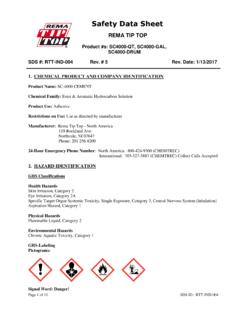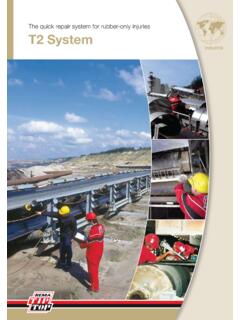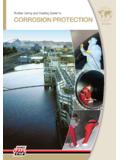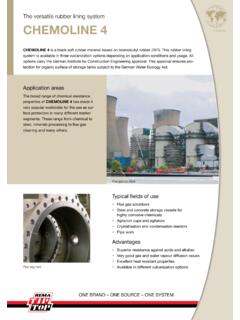Transcription of SC4000 CEMENT Bonding Procedures - REMA TIP …
1 SC4000 CEMENT Bonding ProceduresSC4000 CEMENTB onding Procedures1 rema tip TOP SC4000 CEMENT is the CFC free alternative to our well known and proven SC2000 CEMENT with no compromise to Bonding strength or performance. By using SC4000 CEMENT with the E40 or ER42 Hardener, natural rubber, neoprene rubber, SBR rubber and others can be bonded to each other, to fabric and to steel without the aid of heat, pressure or special TIP TOP SC4000 is a two component, room temperature curing chloroprene based liquid rubber adhesive that, when catalyzed with the appropriate amount of E40 or ER42 Hardener, yields high strength adhesions.
2 SC4000 is ideal for use in lining installations, when Bonding rubber to rubber, rubber to fabric, rubber to steel, rubber to concrete, fi berglass, and urethane, as well as the splicing and repair of fabric conveyor belting. Repair to existing rubber lined vessels and rubber components are also recommended using this instructions Th e SC4000 CEMENT system is comprised of CEMENT and hardener in the ratio of 660 grams of SC4000 CEMENT to 30 grams of E40 or ER42 Hardener. Th ese two components must be thoroughly mixed (stirred) for at least 2 minutes.
3 Th e mixed portion should be used within 2 Rubber Lining Environmental ConditionsBefore any sandblasting, application of metal primer, adhesives or application of lining material the ambient temperature and that of the substrate must be at least + 50 Fahrenheit with a maximum temperature of + 104 to +113 Fahrenheit. Th e Relative Humidity should not exceed 80% during the entire lining e substrate temperature must be a minimum of 5 degrees higher than that of the dew point. Relative humidity, ambient temperature, substrate temperature and dew point must be recorded prior to start of project and at three hour intervals Preparation & Application MethodsRUBBER TO STEELAll surfaces must be clean, dry and free of oil, paint and other contamination.
4 Steel and other metallic surfaces should be sandblasted to a 2-mil blast profi le (SSPC SP10 Near White Metal Blast Cleaning ) to obtain maximum adhesion. Metal surfaces should fi rst be cleaned with rema tip TOP #50 Solvent and then sandblasted and cleaned again with rema tip TOP #50 Solvent. After the surface is prepared it should be primed with rema tip TOP PR200 Metal Primer. Th e primer should be allowed to dry completely, approximately 1 hour depending upon atmospheric conditions. After allowing the prime coat to cure or dry for at least 1 hour, proceed with Bonding e surface should be prepared by fi rst cleaning with rema tip TOP #50 Solvent, then sanded, and recleaned with rema tip TOP #50 Solvent to help remove abraded particles.
5 Allow the solvent to evaporate. Th en the prepared surface must then be primed with SC4000 CEMENT . Th e prime coat of CEMENT should be allowed to completely cure for at least 1 hour (overnight is ideal). After allowing the prime coat to cure, proceed with Bonding TO RUBBERTh e surface should be prepared by fi rst cleaning with rema tip TOP #50 Solvent to remove all mould releases. Rubber that does not have the special rema tip TOP CN Bonding layer requires cleaning with rema tip TOP #50 Solvent and when dry, buffi ng to a RMA #4 textured fi nish.
6 Th e rubber dust should be removed with a dry brush and then wipe the surface with rema tip TOP #50 Solvent again before the prime coat of SC4000 CEMENT is applied to the prepared surface. Th e applicator should use a scrubbing-like motion when applying the SC4000 CEMENT . A scrubbing motion is preferred so that all voids on the buffed surface to be bonded are fi lled in. After allowing the prime coat to cure or dry for at least 1 hour (overnight is ideal) proceed with Bonding Procedures . CONCRETETh e best surface preparation for concrete is sandblasting to provide a clean, dry and sound substrate.
7 When sandblasting is not practical, the surface may be acid etched following the manufacturer s recommendations. After sandblasting or etching, the surface must be primed with SC4000 CEMENT . For ease of application the prime coat could be roller applied by diluting the SC4000 CEMENT with rema tip TOP #50 Solvent, about 25%. Th is dilution will assure better absorption. Th e second coat of SC4000 CEMENT must not be diluted for optimum e best surface preparation for wood is sandblasting. Wood must be dry. After sandblasting, the surface must be primed with SC4000 CEMENT .
8 For ease of application the prime coat could be roller applied by diluting the SC4000 CEMENT with rema tip TOP #50 Solvent, about 25%. Th is dilution will assure better absorption. Th e second coat of SC4000 CEMENT must not be diluted for optimum TO FABRICF abric that is treated should be clean and dry and the number of coats of SC4000 CEMENT will depend on the weight and weave of the fabric. Take special care to insure all indentations are fi lled (such as heavy conveyor belt fabric).BONDINGWhen applying the SC4000 CEMENT a scrubbing motion with a CEMENT brush is preferred so that all voids on the surface to be bonded are fi lled in.
9 Th e fi rst coat of CEMENT on substrate and rubber should be allowed to completely cure for at least 1 hour (overnight is ideal) before the second coat, or tack coat is the properly prepared surfaces apply a tack coat of SC4000 CEMENT to each surface at the same time so they dry at the same rate. As rapidly as possible, apply a uniform coat with a brush. Avoid heavy builds, puddles, uneven coating. Surfaces must dry surfaces dry to a tack, about 6-8 minutes, they are ready to bond (if the surfaces become too dry, apply another tack coat to each).
10 Test the CEMENT with the back of a dry fi nger, it should feel tacky (somewhat dry) and not leave any CEMENT on the fi nger. Join surfaces and roll from the center to the edges with a 2 wide roller (stitcher) with appropriate pressure to bond surfaces together and eliminate air entrapment between substrate and rubber. Use overlapping roller strokes making sure both surfaces fully contact each other and all air is CEMENTB onding Procedures2 Surface Preparation & Application Methods (continued)TECHNICAL DATABond EvaluationSC4000 is capable of Bonding rema tip TOP CN/Rubber to steel in the range of 70-80 lbs peel per inch width.



